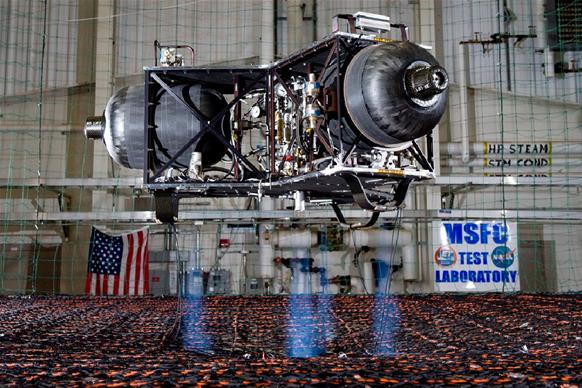Lift Off for a Robotic Lunar Lander
NASA tests a new power system.
This week, NASA and Johns Hopkins University tested a new propulsion system for a prototype robotic lander they are jointly developing. While the robot didn’t leave the ground, the “hot-fire” tests successfully verified the performance of its thrusters.

The propulsion system was developed by Dynetics Corp, an engineering company in Huntsville, Alabama. According the NASA press release:
The prototype’s new propulsion system consists of 12 small attitude control thrusters, three primary descent thrusters to control the vehicle’s altitude, and one large “gravity-canceling” thruster which offsets a portion of the prototype’s weight to simulate a lower gravity environment, like that of the moon and asteroids. The prototype uses a green propellant, hydrogen peroxide, in a stronger concentration of a solution commonly used in homes as a disinfectant. The by-products after use are water and oxygen.
The robotic lunar lander is part of a larger NASA project to develop smart, versatile, and autonomous robots that can explore the moon and near-Earth asteroids. The agency’s goal for the robotic lunar lander prototype is for it to fly up to 60 seconds with a controlled landing in a simulated low gravity environment. Flight tests began in 2009 and thus far 142 have been conducted. The robotic lander currently has a record flight time of ten seconds and a descent altitude of three meters.

Keep Reading
Most Popular
How scientists traced a mysterious covid case back to six toilets
When wastewater surveillance turns into a hunt for a single infected individual, the ethics get tricky.
The problem with plug-in hybrids? Their drivers.
Plug-in hybrids are often sold as a transition to EVs, but new data from Europe shows we’re still underestimating the emissions they produce.
What’s next for generative video
OpenAI's Sora has raised the bar for AI moviemaking. Here are four things to bear in mind as we wrap our heads around what's coming.
Stay connected
Get the latest updates from
MIT Technology Review
Discover special offers, top stories, upcoming events, and more.